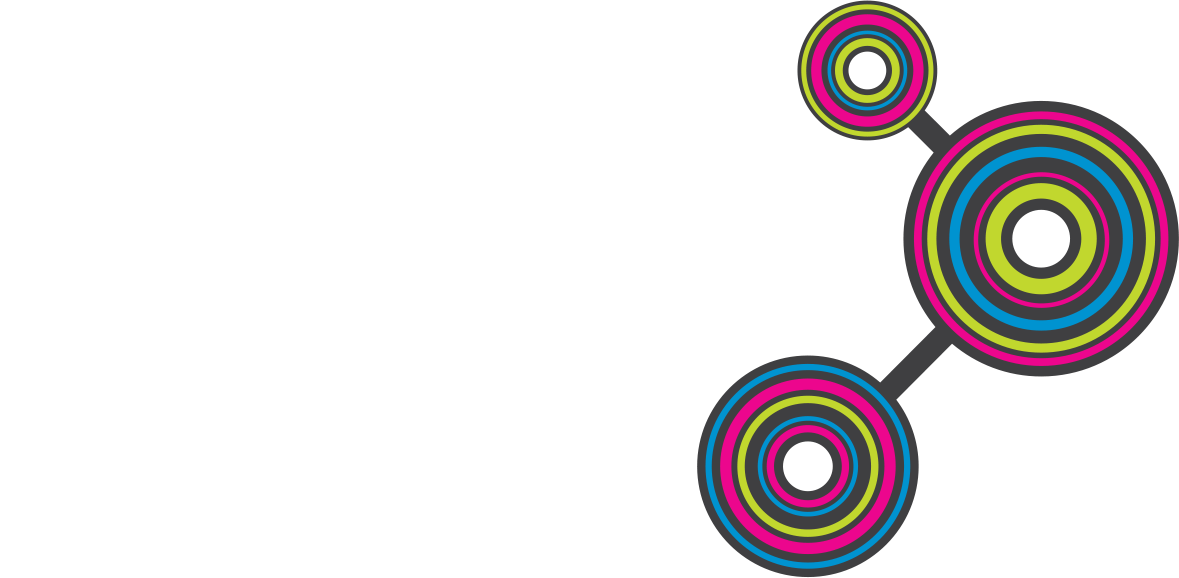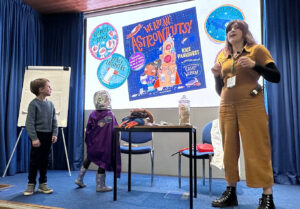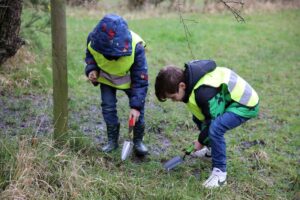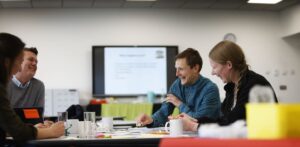Scooting through science on Rowena’s Roadtrip
Thursday 23rd November 2017
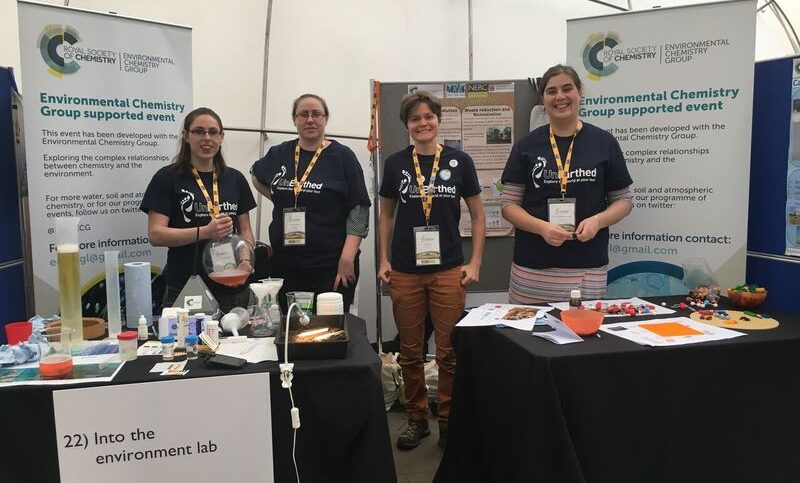
Chemist, science communicator, rock climber and avid scooter fan – find out what happened when our Events Officer Rowena Fletcher Wood took to her wheels and called in at two inspiring public science events across two UK cities, in a super-sonic SciFly-By..
This November, I went on a road trip (well, train and scooter trip) to two stunning Northern cities, Edinburgh and Durham. I was in Edinburgh for the Natural Environment Research Council’s annual outreach event…UnEarthed. Explore the world at your feet..
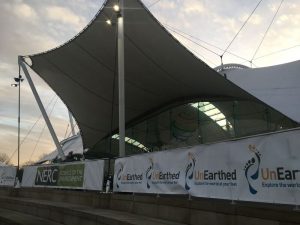
This four-day extravaganza, hosted by the city’s Dynamic Earth Science Centre, is an “interactive exhibition offering people of all ages the chance to get closer to the environmental science that shapes their lives” and brings together chemists, physicists, geologists, geographers, biologists and environmental scientists to engage with the public about research and issues such as:
“How do we look after our coastlines? Can we make the air we breathe better for us? Can we make natural disasters less disastrous? What can we do to get more food out of the same soil? How can we generate energy for the future?”
Organisations involved include the British Antarctic Survey, the Met Office and the Centre for Ecology and Hydrology. I was there with the Environmental Chemistry Group from the Royal Society of Chemistry, running activities including:
- searching for microplastics in soil samples to highlight the challenge of cleaning up the environment
- testing and comparing water from the Peak District and Edinburgh, filtering coloured salts from contaminated water using zeolites – a naturally occurring volcanic rock used in water softeners and filters at home
- monitoring the air quality of the Dynamic Earth centre itself.
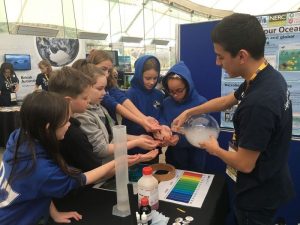 Our most popular experiment was the ocean acidification experiment, where we use dry ice to see what happens to seawater when it’s exposed to carbon. We used a pH indicator to measure the changes to the seawater and – although the neutral to red colour change was sometimes hard to see (as we needed more indicator) – the exotic bubbling of the dry ice enthralled our visitors. It also made the air quality monitors go crazy, not just on our own stand, but also on the neighbouring ones!
Our most popular experiment was the ocean acidification experiment, where we use dry ice to see what happens to seawater when it’s exposed to carbon. We used a pH indicator to measure the changes to the seawater and – although the neutral to red colour change was sometimes hard to see (as we needed more indicator) – the exotic bubbling of the dry ice enthralled our visitors. It also made the air quality monitors go crazy, not just on our own stand, but also on the neighbouring ones!
For me, the most surprising discovery of the day was just how much children enjoy sifting through soil to extract the tiny bits of coloured plastic. It was hard to tear them away, or to sneakily mix the plastic back into the soil, so somebody else could have a go! It’s also worth remembering to have good lighting – we ran the same activity last year in Manchester, but it was demonstrably less effective as we were underneath the wing of a plane (!), casting our entire exhibit into darkness and making detailed soil work impossible.
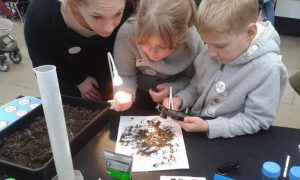 The exhibition really engaged with audiences. On Twitter #Unearthed went bananas – for six hours on the first day it was the top-trending hashtag in Scotland. It was also exhausting: we saw over 7000 visitors in 4 days. Several researchers lost their voices, and a regular supply of tea, coffee, and snacks proved invaluable. If you’re on a stall, I recommend overstaffing your table, doing half day shifts, and building in short breaks whenever the crowds ebb!
The exhibition really engaged with audiences. On Twitter #Unearthed went bananas – for six hours on the first day it was the top-trending hashtag in Scotland. It was also exhausting: we saw over 7000 visitors in 4 days. Several researchers lost their voices, and a regular supply of tea, coffee, and snacks proved invaluable. If you’re on a stall, I recommend overstaffing your table, doing half day shifts, and building in short breaks whenever the crowds ebb!
However, there’s no rest for the wicked – after a quick visit to the local whisky shop, I was back on the train and heading for Durham, a historic town with a majestic university, and home of the Centre for Visual Arts and Culture……
It was a completely different kind of science, and a completely different kind of event which brought me to St Mary’s College Durham. In fact, I’m not even sure it makes sense to call it science – for this was a meeting of dissimilar disciplines at the interface between science and the arts.
Durham University Institute for Advanced Studies hosted a two-day conference: Molecules and Models- Seeing Structures. Visitors and speakers alongside myself included chemists and crystallographers, a physicist, several historians, some philosophers, and more than one literature researcher. The discussions were lively and thorough and everyone was excited by the interdisciplinary nature of the event.
Models is interpreted in its broadest sense, including physical models, metaphorical models, and the verb ‘to model’. John Dalton was the first scientist to use symbols to represent elements in a short way, and we began with a talk on the history of Dalton’s symbols and the development of the modelling paradigm, explored the concept of models as language, examined their diversity and thought about who they were created for – often the scientist solving a structure, and only later used before an audience.
“DNA sequencing genealogy, where individuals are sold the chance to regain an aspect of their identity they didn’t know was lost.”
Another talk looked at the emotional connections of models, how they are presented to children and can impact our identity, and can convert us to a view of the world around us. Nowhere is this more true, of course, than in DNA sequencing genealogy, where individuals are sold the chance to regain an aspect of their identity they didn’t know was lost. They are used to interpret their genome, but data interpretation is still the property of ‘experts’ and public access is mediated. Whilst the findings from your genome sequence could impact your sense of humanness, uniting you with others yet individualising you, 99.9% of people wouldn’t understand the actual sequence.
Most excitingly for me, Dorothy Crowfoot Hodgkin’s daughter (and last DPhil student), Judith Howard were there to speak about the Nobel Prize winning crystallographic chemist who, back in her school days was told her chemistry was “good on the whole”. They also brought several of her crystals, models, and notebooks for us to admire and handle. As a chemist, you can only imagine how exciting this was for me, and I was unable to resist retelling my own Dorothy Hodgkin story when my talk came around.
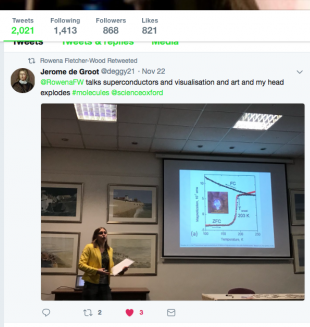
I will leave you with two of my favourite quotes from the conference:
“450kg of dried spinach were exhaustively extracted with acetone…”
“Model provides a thing for something that is not wholly a thing, and when you give it an author, you doubly thing it”
And now – I have a train to catch!
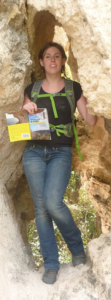
Rowena Fletcher Wood is a part time Events Officer at Science Oxford, a Science Communicator and chemist. After having received First Class Honours in Chemistry at the University of Oxford she went on to complete a PhD at the University of Birmingham on “Zeolites and other molecular sieves for chromate remediation”. Rowena has been tutoring in Chemistry for the last 10 years and during that time was also a Research Fellow in Physical Chemistry at the University of Birmingham. Rowena is also a fully qualified rock-climbing instructor.
